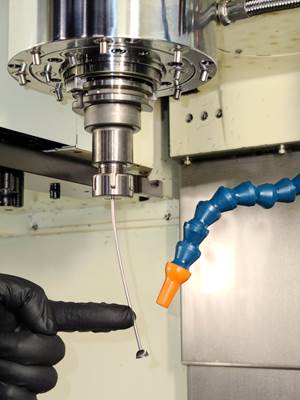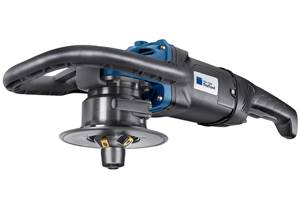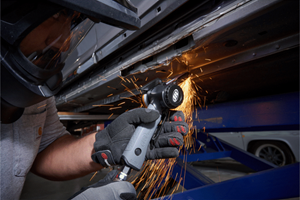Aerospace Manufacturer Produces 'Perfect' Pins To Secure Arrays
Imagine the space shuttle delivering a space station payload into orbit when suddenly, the locking mechanism holding the 100-foot-long array of solar panels fails, and out pops the entire solar panel array.
Did your umbrella ever open in your car—while you were driving? Not a big deal, though you would not be pleased with the quality of the locking mechanism. But imagine the space shuttle delivering a space station payload into orbit when suddenly, the locking mechanism holding the 100-foot-long array of solar panels fails, and out pops the entire solar panel array.
Perfection is the standard set by the National Aeronautic and Space Administration (NASA) and its suppliers for such a locking mechanism. Lockheed Martin Missile and Space Systems is the contractor responsible for manufacturing the solar arrays that go on the upcoming International Space Station project.
The solar arrays are each 108 feet long by 38 feet wide. They contain the solar panels that will provide the electricity needed to run everything on the space station. Although they are quite large when fully extended, they are not launched that way. They are manufactured so they can be folded accordion-style into a smaller package for the launch and then extended once in orbit. Once they are folded up, they have to be secured so that, when going through the rigors of a launch, they do not break from vibration or the increased G force. Once they are folded up, the pins are inserted into mounting brackets on the assembly as it is folded. One flight wing requires 14 pins and there are eight flight wings on the space station. The locking pins secure the solar panels in place so there is no damage before they are extended.
The stainless steel pins are actually made up of two components. One is the expandable pin. The second part of the assembly is a component called the tapered pin. The tapered pin is a solid pin that inserts into the expandable pin (which of course, expands). This is what locks the solar array in place. And it must be a very intimate fit between the tapered pin and the expandable pin so that there is no unwanted movement when the assembly is locked.
Lockheed Martin was originally manufacturing the expandable pin by a reaming operation. The center bore of the pin, however, still required a special finishing operation (called abrasive flow machining) to improve the surface condition. Randy Gilmore, manager of SoneX Division of Extrude Hone Corporation (Irwin, Pennsylvania), explains how abrasive flow works: "Abrasive flow machining is...a process where we use a polymer that is laden with abrasives. It's a viscoelastic polymer (which we commonly call `media') that, under pressure or under shear, is transformed into a semi-solid state. Take that, and mix abrasives into it and you basically have our media. It's a rubbery substance, but if you lay it on a table top and just let it sit there for any period of time, it does cold-flow as a liquid would flow. It's just a very high viscosity liquid. So, although it is flowable and can reach all the nooks and crannies in a part, once it is pressurized, it is solid like a file or a piece of sandpaper that we can stroke back and forth inside the component in order to polish. Once the pressure is relieved, it is liquid again."
Lockheed Martin went to Extrude Hone and asked them to finish the pin for them.
Extrude Hone does a lot of work for the Department of Defense (DoD) and DoD suppliers such as Pratt & Whitney Aircraft, General Electric and Allison—companies that build jet aircraft components and aerospace components like space shuttle rockets.
But in order to do some preliminary process development, Extrude Hone needed some sample components. That is when Randy Gilmore got involved. His division handles all of the company's EDM work. As Mr. Gilmore tells it, "Our abrasive flow people asked us to help them out by EDMing some components to give them the near shape so that they could do some development work with the parts. We did that, they did some abrasive flow work and it was returned to the customer. The customer wanted to know how in the world we did this. They said the reaming process was driving them crazy and it was costing them an arm and a leg. Part delivery was unreliable because the process was unreliable. We explained to them that we were doing it with ram EDMs. Then they asked us if we would entertain the thought of not only doing the abrasive flow but also the machining of the internal bore and wire cutting as well."
Though the SoneX Division had ram EDMs, they didn't have the type of wire EDM necessary to make the expandable pin. The wire EDM is needed to cut tines all the way through the part. The expandable pin is approximately 1 to 1 1/4 inches at the major end and tapers down to between a half-inch and three-quarters of an inch at the minor end (the length is approximately 18 inches). To cut the tines, the tapered pin (with hollow ID) is fixtured in the EDM in a horizontal position. The tines are cut through the top and bottom walls of the pin simultaneously—through 75 percent of the pin. There is a total of 12 slots. Those slots are about 6 inches long and the width of the slots is 13 thousandths (0.0013) inch. When it's finished, it looks very much like a collet and acts more like a spring rather than as a solid piece of material.
Mr. Gilmore explains why they bought the Sodick A320D: "We're dealing here with hollow pins, so if you imagine it as a tube and you are trying to cut the top wall and bottom wall simultaneously, right in the center where it's hollow, it's prone to cause the wire to break due to poor flushing. So we were leaning toward a submerged machine so that we could always have fluid, even inside the ID of the expandable pin. A non-submerged machine would leave a dry spot on the ID of this tube, which would lead to more and more wire breakage. If we break a wire, it can lead to that part being scrapped simply by virtue of the wire having broken and leaving a witness mark on the break. Our customer is very, very picky about anything that is an anomaly that could lead to a stress riser and, therefore, to early fatigue failure."
Mr. Gilmore says they are very happy with their choice. He says they "...have not had anything that has caused us to go into nonconformance due to a wire machine problem and we're approximately halfway through the contract now."
Future plans for the Sodick A320D wire EDM (after completion of the space station project) include tooling support for some of the company's other divisions within the corporation as well as incoming contract work.
Related Content
How to Accelerate Robotic Deburring & Automated Material Removal
Pairing automation with air-driven motors that push cutting tool speeds up to 65,000 RPM with no duty cycle can dramatically improve throughput and improve finishing.
Read MoreAutomated and Manual Deburring With One Tool
IMTS22: J.W. Done Corp. showcases its Orbitool, one tool capable of automated and manual deburring. The tool is capable of working on several differently sized holes.
Read MoreTrumpf Deburring Tool Provides Repeatable Accuracy
The TruTool TKA 1500 edge milling tool is now available with a new cutting mount and guide fence for increased applications and safety.
Read MoreIngersoll Rand Offers Two New Belt Sanders for Smooth Finishes
Ingersoll Rand’s 360-313 and 360-418 Pneumatic Belt Sanders work effectively on metal, plastic, fiberglass, wood and other materials.
Read MoreRead Next
The Cut Scene: The Finer Details of Large-Format Machining
Small details and features can have an outsized impact on large parts, such as Barbco’s collapsible utility drill head.
Read More3 Mistakes That Cause CNC Programs to Fail
Despite enhancements to manufacturing technology, there are still issues today that can cause programs to fail. These failures can cause lost time, scrapped parts, damaged machines and even injured operators.
Read More









.png;maxWidth=300;quality=90)









.png;maxWidth=300;quality=90)









